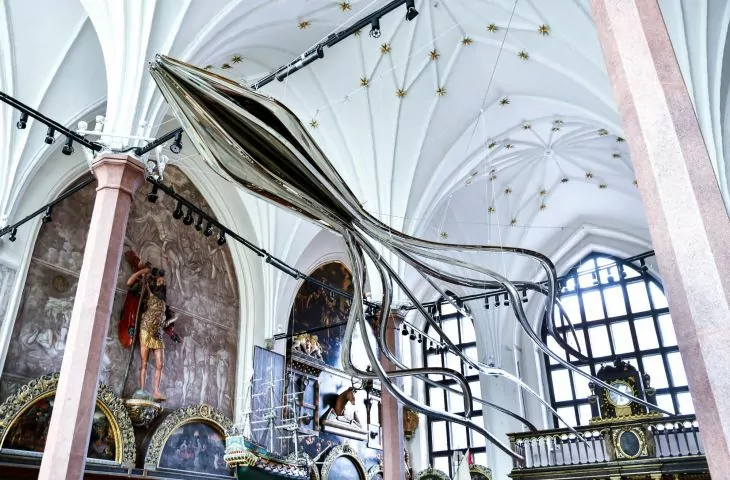The nearly 14-meter-long, 250-kilogram steel sculpture depicting the mythical kraken monster will hover over the heads of visitors to Gdansk's Artus Court until the end of November this year. In the sculpture, as in a mirror are reflected the blast furnace, paintings and historical models of ships from the collection of the Gdansk Museum. The author of the installation is Oskar Zięta, an internationally known designer.
Oskar Zięta is an architect, artist and designer who has created more than 200 original functional forms. Zięta is also the author of sculptures in public space that reflect his experimental approach to design - NAWA, WIR or Firefly. In 2004, he developed his proprietary FiDU method, which involves shaping steel with coupled air. The results of this craft are objects that resemble inflated balloons, with highly original and unique shapes.
A Kraken drifts under the Gothic vault of Artus Court
photo by A. Grabowska
legend of the deep sea
This time the designer was invited to Gdansk to create artistic interventions there in the Uphagen House and Artus Court. He looked for inspiration in the history of Gdansk inextricably linked to the sea. This led to the creation of the kraken - a legendary creature from the sea depths. Pliny the Elder already wrote about the monster - supposedly the creature inhabited the Strait of Gibraltar, where it attacked ships passing through there. In the modern era, however, the monstrosity was described by Erik Pontoppidan in Natural history of Norway in 1752.
Oskar Zięta's Kraken is intimidating in its size. The steel sculpture, suspended under the Gothic vault of Artus Court, consists of an almost four-meter-long head, from which grow eight, waving tentacles ranging from 5 to 10 meters in length.
The Kraken is almost 14 meters long
photo by A. Grabowska
TheKraken is a mythical terror of sailors. We prepared the modern sculpture, a giant experiment, to correspond with the decor of the place, but also of Gdansk. It was in Artus Court that merchants and diplomats met, it was here that all sorts of stories about sea monsters were told to each other, and it is on Długi Targ that there is a fountain of Neptune, whose son Triton was the guardian of the sea monster. I hope that such a prepared and thoughtful intervention in the history of two interesting branches of the Gdansk Museum will become one of the summer tourist attractions of Gdansk," Oskar Zięta said at the press conference.
The Kraken floats in the Great Hall between historic ship models that were created for trade with the East India Campaign. The steel creature brings to mind the sea depths, but it's not hard to associate it with Philippe Starck's iconic citrus squeezer or Louise Bourgeois' sculptures.
Oskar Zięta during the installation of Kraken
photo by Dariusz Kula
contrast of the past with the modern
Museum officials admit that both the installation and the temporary exhibition "In the depths of reflection" arouse great emotions.
Museum professionals are caretakers of historical sites, but sometimes they decide to experiment, especially those that aim to make viewers reflect on our past and future. That's why we started working with Oskar Zięta, seeing in the contrast - the past with the modern to evoke curiosity, reflection and emotion in the viewer. The temporary exhibition is also an offer addressed to Danzigers to rediscover their own heritage and history in a new context," said Dr. Ewa Szymanska, deputy director of the Gdansk Museum for content-related issues, at a press conference.
The exhibition can be visited until the end of November this year.
Photo: Dariusz Kula
The installation is part of the "In Depth of Reflection" exhibition, which can be visited in two branches of the Gdansk Museum - Artus Court and Uphagen House - until November 28 this year. In the historic interiors, visitors can see more than a hundred of Oskar Zięta's original designs in the form of chairs, mirrors and other objects that stood next to historical exhibits. The projects made of steel, copper and aluminum feature the eponymous "depth of reflection," in which historic spaces, works of art and museum exhibits are transformed in reflections of shiny, polished steel.
Gdynia, too, can boast new sculptures in urban space. As of recently, Stolemka and Bohemian Mist can be admired in the St. Maximilian Hill neighborhood. Meanwhile, the controversial Echo by Xawery Wolski stood in Sopot.














































